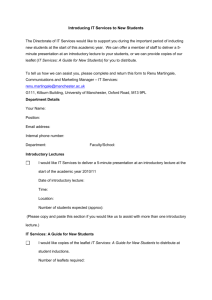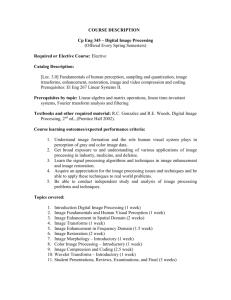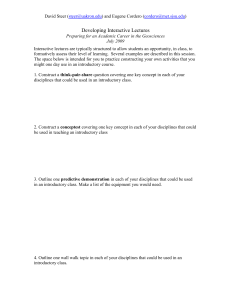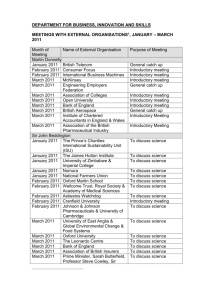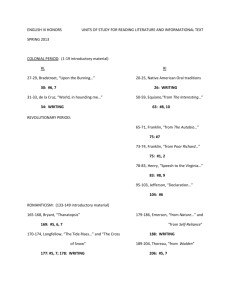Digital image processing
advertisement
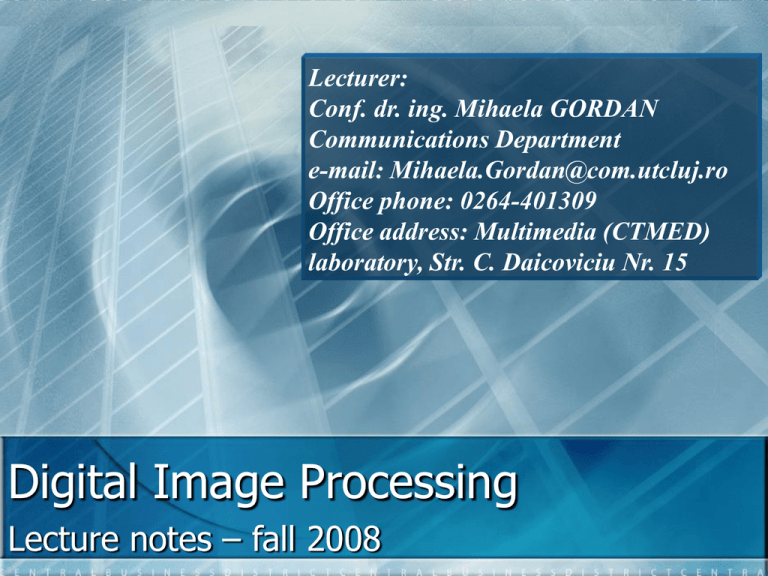
Lecturer: Conf. dr. ing. Mihaela GORDAN Communications Department e-mail: Mihaela.Gordan@com.utcluj.ro Office phone: 0264-401309 Office address: Multimedia (CTMED) laboratory, Str. C. Daicoviciu Nr. 15 Digital Image Processing Lecture notes – fall 2008 Digital Image Processing Lecture 1 – Introductory Lecture 1 • Introduction • Course description • Exam grade information Digital Image Processing Lecture 1 – Introductory Introduction (1) Digital image processing: • deals with digital images = digital representation of the visual scenes • Note that: visual perception can be static (scene content unchanged in time) or dynamic (scene content changes in time); the latest case = video sequence; • Typically, visual scene = a static image, a “snap shot” • tries to: • “implement” in digital (algorithmic) form various human vision processes => image analysis & understanding, pattern recognition • “improve” image appearance for human visualization => image enhancement, de-noising; BASIC IMAGE PROCESSING • store and transmit images efficiently => image compression Digital Image Processing Lecture 1 – Introductory Introduction (2) Applications of digital image processing? … virtually, everywhere! • Industry: inspection/sorting; manufacturing (robot vision) • Environment: strategic surveillance (hydro-dams, forests, forest fires, mine galleries) by surveillance cameras, autonomous robots • Medicine: medical imaging (ultrasound, MRI, CT, visible) • Culture: digital libraries; cultural heritage preservation (storage, restoration, analysis – indexing) • Television: broadcasting, video editing, efficient storage • Education & tourism: multi-modal, intelligent human-computer interfaces, with emotion recognition components • Security/authentication (iris recognition, signature verification) … etc… Digital Image Processing Lecture 1 – Introductory Introduction (3) • Industrial inspection (industrial vision systems): Digital Image Processing Lecture 1 – Introductory Introduction (4) Water sources inspection: • Environment surveillance/monitoring: Forest fire monitoring Hydro sites surveillance Digital Image Processing Lecture 1 – Introductory Introduction (5) • Medical imaging applications: Color image segmentation & Cells counting Ultrasound image analysis/quantification Digital Image Processing Lecture 1 – Introductory Course description (1) … Obviously, digital image processing is a very wide field, sooo… …What will we study in 1 semester…? • Just the basics you need to develop & implement image processing & analysis algorithms from all the categories above! • Simplification: - only grey level images - only basic processing methods, without their combination Digital Image Processing Lecture 1 – Introductory Course description (2) • I. Course chapters: Grey level digital image representation. Basic math concepts for digital image processing algorithms II. Grey level image digitization: II. 1. Image sampling II. 2. Image quantization III. Image transforms: digital image representation in frequency domains; applications: noise filtering, compression, recognition III. 1. Basic properties III. 2. Sinusoidal transforms III. 3. Rectangular transforms III. 4. Eigenvector-based transforms Digital Image Processing Lecture 1 – Introductory Course description (3) IV. Image enhancement: IV. 1. Point operations IV. 2. Grey level histogram; histogram-based enhancement IV. 3. Spatial operations IV. 4. Transform-based operations IV. 5. Color image enhancement & pseudo-coloring V. Image analysis & understanding: V.1. Regions of interest; features; feature extraction V. 2. Edge detection, boundary extraction & representation V. 3. Regions detection, extraction & representation V. 4. Binary object structure analysis & representation: median axis transforms; binary morphology Digital Image Processing Lecture 1 – Introductory Course description (4) V. 5. Shape descriptors V. 6. Texture representation; texture descriptors V. 7. Region-based image segmentation VI. Image compression & coding: VI. 1. Introduction VI. 2. Pixel coding VI. 3. Predictive coding of still images VI. 4. Transform coding of still images VI. 5. Video sequence (inter-frame) coding … all with practical examples given – in the lectures & lab! Digital Image Processing Lecture 1 – Introductory Exam grade information • The grade components: 1) Written exam – quiz: => max. 3.5 pts - 6 questions from theory - 6 questions from problems/exercises 2) Written exam – classic: => max. 6.5 pts - 5 short theoretic subjects (max. ½ page answer) - 5 problems/exercises => Written exam grade E=1…10 3) Laboratory work evaluation: => grade L=1…10 4) Lecture participation/discussions: => grade LD=1…10 5) Project evaluation: => grade P=1…10 ____________________________________________________________________ The grade = 0.75(0.7E+0.2L+0.1LD)+0.25P To pass the exam: must have E≥ 5, L≥ 5.
